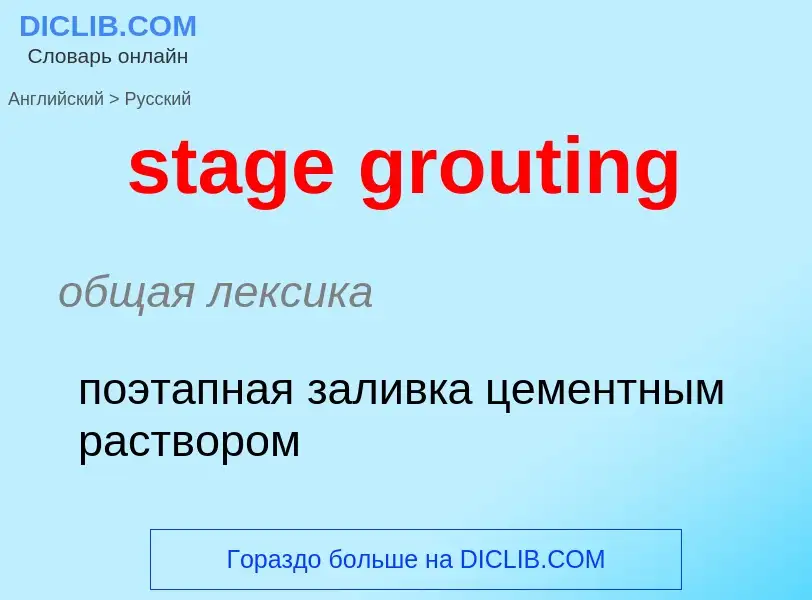Перевод и анализ слов искусственным интеллектом ChatGPT
На этой странице Вы можете получить подробный анализ слова или словосочетания, произведенный с помощью лучшей на сегодняшний день технологии искусственного интеллекта:
- как употребляется слово
- частота употребления
- используется оно чаще в устной или письменной речи
- варианты перевода слова
- примеры употребления (несколько фраз с переводом)
- этимология
stage grouting - перевод на русский
общая лексика
поэтапная заливка цементным раствором
строительное дело
прерывистая цементация
['steidʒhænd]
существительное
общая лексика
рабочий сцены
существительное
общая лексика
почтовая карета, дилижанс
['steidʒiŋpəust]
общая лексика
стоянка (во время путешествия)
этап (пути)
важная подготовительная стадия
место сосредоточения войск перед операцией
военное дело
этапный пункт
промежуточный аэродром
существительное
общая лексика
стоянка (во время путешествия)
этап (пути)
важная подготовительная стадия
['steidʒkəutʃ]
существительное
общая лексика
почтовая карета
дилижанс
Определение
Википедия

Grout is a dense fluid that hardens to fill gaps or used as reinforcement in existing structures. Grout is generally a mixture of water, cement, and sand, and is employed in pressure grouting, embedding rebar in masonry walls, connecting sections of precast concrete, filling voids, and sealing joints such as those between tiles. Common uses for grout in the household include filling in tiles of shower floors and kitchen tiles. It is often color tinted when it has to be kept visible and sometimes includes fine gravel when being used to fill large spaces (such as the cores of concrete blocks). Unlike other structural pastes such as plaster or joint compound, correctly mixed and applied grout forms a water-resistant seal.
Although both grout and its close relative mortar are applied as a thick suspension and harden over time, grout is distinguished by its low viscosity and lack of lime (added to mortar for pliability); grout is thin so it flows readily into gaps, while mortar is thick enough to support not only its own weight, but also that of masonry placed above it.




![Brewster]] in 1887 Brewster]] in 1887](https://commons.wikimedia.org/wiki/Special:FilePath/Brewster park drag 1887.jpg?width=200)
![Carriage driving, 1881. The owner's coachman watches<br>[[Henri de Toulouse-Lautrec]] Carriage driving, 1881. The owner's coachman watches<br>[[Henri de Toulouse-Lautrec]]](https://commons.wikimedia.org/wiki/Special:FilePath/Henri de Toulouse-Lautrec 024.jpg?width=200)


![Bisbee]] route Bisbee]] route](https://commons.wikimedia.org/wiki/Special:FilePath/Kinnear Express stage 1880.jpg?width=200)
![McLaughlin Stagecoach with birthday party, 1880s in [[Park County, Colorado]]. McLaughlin Stagecoach with birthday party, 1880s in [[Park County, Colorado]].](https://commons.wikimedia.org/wiki/Special:FilePath/McLaughlin stagecoach, circa 1880s - DPLA - 294b58f952c4bb69ac1c19a050817dfb.jpg?width=200)
![A public notice advertising a new stage coach service in west [[Wales]], 1831 A public notice advertising a new stage coach service in west [[Wales]], 1831](https://commons.wikimedia.org/wiki/Special:FilePath/The Public are Respectfully Informed that a neat and convenient stage coach..1831.jpg?width=200)
 (14780079804).jpg?width=200)
.jpg?width=200)

![Place de Passy]], Paris Place de Passy]], Paris](https://commons.wikimedia.org/wiki/Special:FilePath/A Coach Stop on the Place de Passy - Edmond Georges Grandjean - Google Cultural Institute.jpg?width=200)
![The Bull and Mouth's yard,<br>[[St. Martin's Le Grand]] in 1838 The Bull and Mouth's yard,<br>[[St. Martin's Le Grand]] in 1838](https://commons.wikimedia.org/wiki/Special:FilePath/Bull and Mouth Yard (18410240162).jpg?width=200)
.jpg?width=200)
.jpg?width=200)
![The empty yard of [[The George Inn, Southwark]] in 1889 The empty yard of [[The George Inn, Southwark]] in 1889](https://commons.wikimedia.org/wiki/Special:FilePath/George Inn, Southwark 1889.jpg?width=200)

![Black Horse relais de poste, [[Copenhagen]] Black Horse relais de poste, [[Copenhagen]]](https://commons.wikimedia.org/wiki/Special:FilePath/SorteHest.jpg?width=200)

 (Hautes Pyrénées) - Fonds Ancely - B315556101 A JACOTTET 1 037 (cropped).jpg?width=200)
